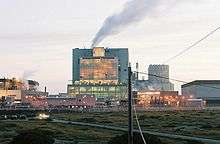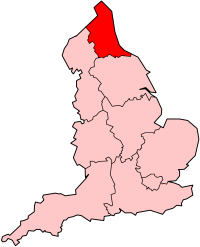C. A. Parsons and Company
C. A. Parsons and Company was a British engineering firm which was once one of the largest employers on Tyneside. The company became Reyrolle Parsons in 1968, merged with Clarke Chapman to form Northern Engineering Industries in 1977, became part of Rolls-Royce plc in 1989, and still survives today as a division of Siemens.
| Public | |
| Industry | Engineering |
| Fate | Acquired |
| Predecessor | Parsons Marine Steam Turbine Company |
| Successor | Siemens AG |
| Founded | 1889 |
| Defunct | 1997 |
| Headquarters | Newcastle upon Tyne, UK |
History

The Company was founded by Charles Algernon Parsons in 1889 to produce steam turbines, his own invention.[1] At the beginning of the 20th century, the company was producing up to 50 turbines a year at its factory in Heaton in Newcastle upon Tyne.[2]
During the First World War, the Parsons’ Works on Shields Road during the First World War employed a large number of women on the factory floor.[3]
The company's heyday was in the 1960s, when the factory employed more than 7,000 people at its 100 acres (40 ha) split site.[2]
Nuclear power stations using Parsons steam turbines include Bradwell, Calder Hall, Dungeness, Heysham 2 and Oldbury in England[4] and Chapelcross and Hunterston in Scotland.[5]
The company merged with A. Reyrolle & Company to form Reyrolle Parsons in 1968.[6] In 1977 Reyrolle Parsons merged with Clarke Chapman to form Northern Engineering Industries plc, which itself was acquired by Rolls-Royce plc in 1989.[6]
The company survives today as part of the power generation division of the industrial conglomerate, Siemens, who acquired the business from Rolls-Royce in 1997.[7] Siemens announced in late 2002 that they would be cutting 400 of the 700 jobs at the Heaton works by 2004, shifting the operation to focusing on the servicing side of the business, blaming a downturn in world markets following the 11 September attacks and Enron scandal, creating a downturn in orders in 2003. They also announced they would be focusing their manufacturing operations at their factory in Budapest, where labour was cheaper.[2]
Parsons turbines are on display in several museums in the UK, and across the world. These include the Discovery Museum in Newcastle, the Science Museum in London, and the Electric Power and Historical Museum, in Yokohama, Japan.[2]
Parsons also patented and made novel searchlight mirrors between 1894 and 1923.[8]
See also
- Parsons Marine Steam Turbine Company
- Grubb Parsons
- A. Reyrolle & Company
- Clarke Chapman
- Mechanical Engineering Heritage (Japan) No. 4; Parsons Steam Turbine, made in 1908, upon technical licensed to Mitsubishi-Japan in 1904.
References
- "Chronology of Charles Parsons". Birr Castle Demesne. Archived from the original on 25 December 2008.
- Young, Peter (6 May 2003). "Generating a big demand". Evening Chronicle. Retrieved 13 September 2011.
- "Parsons' 'Women Labourers' photograph album, taken at Parsons' Works on Shields Road during the First World War". Tyne and Wear Museums and Archives.
- "Nuclear Power Plants in the UK - England". Archived from the original on 19 July 2009. Retrieved 16 March 2008.
- "Nuclear Power Plants in the UK - Scotland". Archived from the original on 19 July 2009. Retrieved 16 March 2008.
- NZR Cranes Archived 3 March 2016 at the Wayback Machine
- Ward, David (29 August 2002). "Violence mars Leeds Festival". The Guardian. London.
- Scaife, W.G.S (1 January 1999). "From Galaxies to Turbines: Science, Technology and the Parsons Family". CRC Press. Retrieved 30 March 2016.
